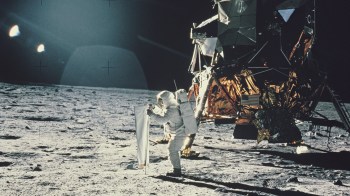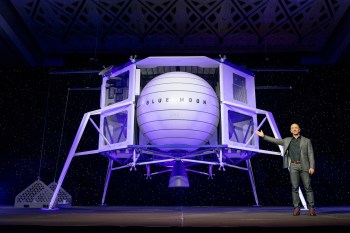The space program is obviously getting a lot of attention this week with the anniversary of the moon landing. It’s a good time to ask, where should we be spending our money when it comes to space travel?
The debate seems to be focused on whether NASA should send people to the moon again or to Mars instead. The Christian Science Monitor points out the advantages of each. First, the moon:
Advocates, including former Apollo 17 astronaut Harrison Schmidt, point to the abundance of helium-3, which can be used to generate energy in future fusion reactors. And if tantalizing hints of water ice at the bottom of the moon’s polar craters turn out true, explorers would have a ready source of rocket fuel – once they split the water into hydrogen and oxygen.
And, of course, the moon is only three or four days away.
Mars is eight months away, but it has an atmosphere of carbon dioxide that could be turned into fuel. The soil on Mars might also be suitable for growing food. It has some similarities to Earth. Still, it would be a much more difficult and costly mission:
For longtime Mars advocate, Robert Zubrin, these difficulties shouldn’t be showstoppers. He points out that President Kennedy said he picked the goal of a moon landing not because it was easy, but because it was hard.
If the president gives NASA a firm timetable and an adequate budget (say, roughly $40 billion over eight years), humans could land on Mars by 2016 or 2017, with the hardware necessary to sustain themselves and conduct groundbreaking planetary research.
The cost, Mr. Zubrin acknowledges, is not trivial. But, he notes, “It’s much less than the amount we gave to AIG in an afternoon.”
That puts things into a sobering perspective, doesn’t it?
At this point, NASA seems intent on going back to the moon first. But why? From NPR:
“That is a question that I hear quite frequently,” says NASA’s John Olson, who helps direct the agency’s exploration program at the agency’s headquarters in Washington, D.C. “They say, ‘Hey, we’ve been there, done that, got the T-shirt, why, why are we looking at that?'”
This time around, NASA is taking a different approach to the moon, says Olson.
“We’re not going back as a race, we’re not going back for flags and footsteps,” he says. “We’re going back for really what is the beginning of a journey.”
Olson says the reasons for going back to the moon include technology development, scientific exploration, economic expansion, international cooperation and engaging the public. I get most of it, but economic expansion? Does that mean opening ATMs on the moon? I wonder what the housing market will be like …
Anyway, other scientists say NASA should think beyond the moon or Mars, perhaps consider visiting an asteroid since one of them might pay us a unwelcome visit someday.
What do you think? Where would you like to see NASA focus its efforts? Or should we be spending the money on other things?
There’s a lot happening in the world. Through it all, Marketplace is here for you.
You rely on Marketplace to break down the world’s events and tell you how it affects you in a fact-based, approachable way. We rely on your financial support to keep making that possible.
Your donation today powers the independent journalism that you rely on. For just $5/month, you can help sustain Marketplace so we can keep reporting on the things that matter to you.


















